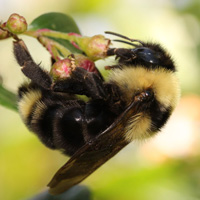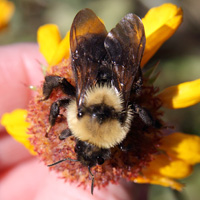Suckley’s Cuckoo Bumble Bee
Scientific name: Bombus suckleyi


Photo credits: Cory Sheffield CC BY 4.0 (left), kimmann CC BY 4.0 (right)
Status
Endangered
“Endangered” means the species lives in the wild in Ontario but is facing imminent extinction or extirpation.
Date added to the Species at Risk in Ontario List
January 25, 2023
Read the assessment report (PDF)
What it looks like
Suckley’s Cuckoo Bumble Bee is medium-sized bumble bee 15 to 25 mm in length. Females are slightly larger than males and have an abdomen (the third section of the body furthest from the head) with shiny black terga (dorsal abdominal segments) and yellow hairs near the tip. Male bees have a similar colour pattern but have more yellow hair on the abdomen.
Gypsy Cuckoo Bumble Bee (Bombus bohemicus) is a similar looking species. Suckley’s Cuckoo Bumble Bee can be distinguished by the prominent triangular ridges on the underside of the last segment of the abdomen. Male Suckley’s Cuckoo Bumble Bees also usually have more yellow hairs on the body.
Where it lives
Suckley’s Cuckoo Bumble Bee occupies diverse habitats that include:
- lowland or montane meadows, or prairies
- farms and croplands
- urban areas
- boreal forest
In early spring, the bumble bee species that are the hosts of Suckley’s Cuckoo Bumble Bee usually establish nests in abandoned underground rodent burrows or other dry, natural hollows. Because Suckley’s Cuckoo Bumble Bee is a nest parasite, these hosts’ residences are part of its habitat.
Suckley’s Cuckoo Bumble Bee is primarily a western Nearctic species, found from southeastern Alaska to northern California, and east to Manitoba and Colorado. This species has been recorded in every Canadian province and territory except for Nunavut. While this species has been recorded on the east coast, it primarily occurs on the west coast, and becomes rarer east of the 100th meridian.
Where it’s been found in Ontario
Historically, Suckley’s Cuckoo Bumble Bee distribution has been sparse and mostly limited to sporadic records in southern Ontario. There are three records of this species in northwestern Ontario near the borders with Manitoba and Minnesota, and one record south of James Bay close to the Quebec border.
There have been extensive bumble bee surveys in southern Ontario that have not yielded any observations of Suckley’s Cuckoo Bumble Bee since 1971. Central and northern Ontario have not been adequately surveyed for bumble bees to determine whether Suckley’s Cuckoo Bumble Bee still occurs there.
What threatens it
Suckley’s Cuckoo Bumble Bee is mostly threatened by the decline of its host species, which are the:
- Western Bumble Bee (Bombus occidentalis) in western Canada
- Yellow-banded Bumble Bee (Bombus terricola) in eastern Canada
These host species have declined in recent years, probably due to:
- pesticide usage
- pathogen spillover from domestic bees
- loss of habitat due to agricultural intensification and natural system modification
As they are parasitic, Suckley’s Cuckoo Bumble Bee, like other cuckoo bumble bees, are less common than their host non-cuckoo bumble bees. They are dependent on the success of their hosts.
Action we are taking
This species and its habitat are protected under Ontario’s Endangered Species Act, 2007.
The ESA also requires the preparation of recovery guidance for endangered species such as Suckley’s Cuckoo Bumble Bee to guide recovery efforts for the species in Ontario.
All species listed on the Species at Risk in Ontario List may be eligible for consideration for government funding through the Species at Risk Stewardship Program.
Recovery strategy
A recovery strategy advises the ministry on ways to ensure healthy numbers of the species return to Ontario.
Read the executive summary and the full document (January 16, 2024).
Government response statement
A government response statement outlines the actions the government intends to take or support to help recover the species.
Read the government response statement (December 20, 2024).
What you can do
Report a sighting
Submit your observations of species at risk to the Natural Heritage Information Centre (NHIC), which is Ontario’s conservation data centre. Join the “(NHIC) Rare Species of Ontario” project in iNaturalist to make submitting your observations quick and easy.
Volunteer
Volunteer with species at risk programs, such as community science surveys, through your local nature club, a provincial park or other conservation organizations.
Be a good steward
- Private landowners have a very important role to play in species recovery. If you find species at risk on your land, you may be eligible for stewardship programs that support the protection and recovery of species at risk and their habitats, such as the Species at Risk Stewardship Program
- Pollinators, such as bees, are in steep decline across the globe and they play a key role in the survival of many of Ontario’s rare plants. To learn more about how you can help pollinators, visit Seeds of Diversity.
- Invasive species seriously threaten many of Ontario’s species at risk. To learn what you can do to help reduce the threat of invasive species, visit:
Report illegal activity
Report any illegal activity related to species at risk to
Quick facts
- Cuckoo bumble bees are obligate social parasites. This means they are dependent on other bumble bee species and their nests to complete their (cuckoo bumble bee) life cycles.
- Female cuckoo bumble bees do not have a corbicula (pollen basket) on their hind leg because they do not collect pollen for their offspring.
- Once a host nest is found, the female cuckoo subdues (or kills) the host queen and ultimately takes over egg laying in the nest, while the workers of the original host queen care for the cuckoo’s offspring.